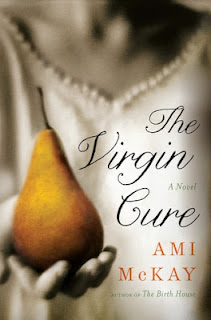The Virgin Cure
Summary (from the publisher): The much-anticipated follow-up to the phenomenon that is The Birth House, The Virgin Cure secures Ami McKay's place as one of our most beguiling storytellers.
"I am Moth, a girl from the lowest part of Chrystie Street, born to a slum-house mystic and the man who broke her heart." So begins The Virgin Cure, a novel set in the tenements of lower Manhattan in the year 1871. As a young child, Moth's father smiled, tipped his hat and walked away from her forever. The summer she turned twelve, her mother sold her as a servant to a wealthy woman, with no intention of ever seeing her again.
These betrayals lead Moth to the wild, murky world of the Bowery, filled with house-thieves, pickpockets, beggars, sideshow freaks and prostitutes, where eventually she meets Miss Everett, the owner of a brothel simply known as "The Infant School." Miss Everett caters to gentlemen who pay dearly for companions who are "willing and clean," and the most desirable of them all are young virgins like Moth.
Through the friendship of Dr. Sadie, a female physician, Moth learns to question and observe the world around her, where her new friends are falling prey to the myth of the "virgin cure"--that deflowering a "fresh maid" can heal the incurable and tainted. She knows the law will not protect her, that polite society ignores her, and still she dreams of answering to no one but herself. There's a high price for such independence, though, and no one knows that better than a girl from Chrystie Street.
Review: I won this novel as a giveaway on Goodreads.
This is the story of Moth, a girl born to poverty in the slums of New York City in 1871. Moth's mother sells her as a servant to an abusive woman when Moth is only 12 years old. From her job as a servant, Moth escapes to live, first on the streets, and then in Miss Everett's "Infant School" that trains young girls to be sold to the highest bidder. The title of the novel refers to the mistaken belief at the time that syphilis could be cured by sleeping with a virgin. Presumably, many of the men who frequent Miss Everett's establishment may have the disease, putting Moth at grave risk.
The frame story of the novel is based on McKay's own family history of a great-great-great grandmother who was a physician at the time period. Dr. Sadie serves as a mentor to the young Moth, and curates her narrative, adding her own notes in the margins of what is supposedly Moth's memoir.
I loved the time frame of this novel, and the subject matter. However, I wasn't wholly pleased with Moth as a narrator. I felt like she never really bonded with anyone, and her story ends prematurely with her only 19 years old, and with a too happy ending. Honestly, I would have preferred to have read Dr. Sadie's life story, as she travels around New York treating the poor, facing prejudice because of her gender as a physician, and pines for the man she loves. That is much more compelling to me than Moth, who (while certainly facing hardships), seems to mostly just worry about herself, and who doesn't have a real love interest the whole novel.
This novel certainly made me think about the plight of poor children and orphans, especially girls, in 19th century New York. Moth was a resourceful character who manages to scrabble her way to the top through her beauty and willingness to be versatile.
Stars: 3



Comments
Post a Comment